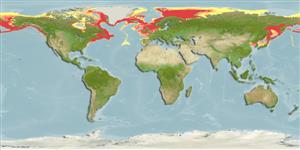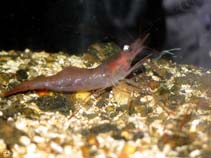Pandalus borealis Krøyer, 1838
Northern shrimp| Native range | All suitable habitat | Point map | Year 2050 |

|
| This map was computer-generated and has not yet been reviewed. |
| Pandalus borealis AquaMaps Data sources: GBIF OBIS |
Classification / Names Common names | Synonyms | CoL | ITIS | WoRMS
Malacostraca | Decapoda | Pandalidae
Environment: milieu / climate zone / depth range / distribution range Ecology
Benthopelagic; depth range 9 - 1450 m (Ref. 85480), usually 50 - 500 m (Ref. 85480). Boreal; -2°C - 12°C (Ref. 85480), preferred 4°C (Ref. 107945); 82°N - 35°N, 180°E - 180°E (Ref. 85480)
Distribution Countries | FAO areas | Ecosystems | Occurrences | Introductions
Circumpolar. Temperate to polar.
Length at first maturity / Size / Weight / Age
Maturity: Lm 2.4, range 2 - 2.443 cm Max length : 12.0 cm TL male/unsexed; (Ref. 8); 16.5 cm TL (female)
Short description Morphology
Commonly known as the "pink" shrimp, it is slender and has a smooth body surface. The shell is somewhat thin, making it more difficult to transport in good condition than the other species. Moreover, although a deep red when alive, it becornes pink after boiling, a quality which also detracts from the commercial value of the unshelled product. The rostrum is about one and three fourths times as long as the carapace, slightly arched above the eyes, terminal half slightly ascending, armed with 12 to 16 teeth above (including 3 or 4 on the carapace), 6 to g teeth below, tip bifid. The anterior dorsal spine is situated at least as far forward as the distal third of the rostrum.
Considered as free-living (Ref. 3123) stenohaline species living on soft substrates with high organic content. It is an opportunistic omnivore functioning as a predator and a scavenger (Ref. 85480).
Life cycle and mating behavior Maturity | Reproduction | Spawning | Eggs | Fecundity | Larvae
Post-larvae mature first as males for 2 years, sex transition begins afterwards. Spawning begins on the third winter, hatching occurs during spring (Ref. 82652). Reproductive mode from Ref. 91801.
Main reference
References | Coordinator | Collaborators
Piepenburg, D., N.V. Chernova, C.F. von Dorrien, J. Gutt, A.V. Neyelov, E. Rachor, L. Saldanha and M.K. Schmid. 1996. (Ref. 2952)
IUCN Red List Status (Ref. 130435)
CITES status (Ref. 108899)
Not Evaluated
CMS (Ref. 116361)
Not Evaluated
Threat to humans
Human uses
Fisheries: commercial
FAO - Fisheries: landings, species profile | FIRMS (Stock assessments) | FishSource | Sea Around Us
Tools
More information
Internet sources
BHL | BOLD Systems | CISTI | DiscoverLife | FAO(Fisheries: species profile; publication : search) | Fishipedia | GenBank (genome, nucleotide) | GloBI | Gomexsi | Google Books | Google Scholar | Google | PubMed | Tree of Life | Wikipedia (Go, Search) | Zoological Record
Estimates based on models
Preferred temperature
(Ref. 115969): -0.9 - 5.6, mean 1.9 (based on 2142 cells).
Resilience
(Ref. 69278):
Medium, minimum population doubling time 1.4 - 4.4 years (K=0.16-0.29; tm=5.71).
Prior r = 0.62, 95% CL = 0.41 - 0.93, Based on 7 full stock assessments.
Nutrients: Calcium = 109 [35, 184] mg/100g; Iron = 1.59 [1.21, 1.97] mg/100g; Protein = 20.2 [19.2, 21.3] %; Omega3 = 0.285 [0.185, 0.386] g/100g; Selenium = 48.3 [-31.7, 128.3] μg/100g; VitaminA = 0 μg/100g; Zinc = 1.79 [1.17, 2.40] mg/100g (wet weight).



